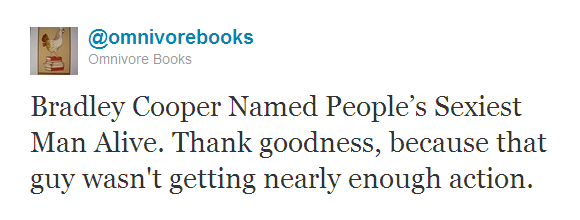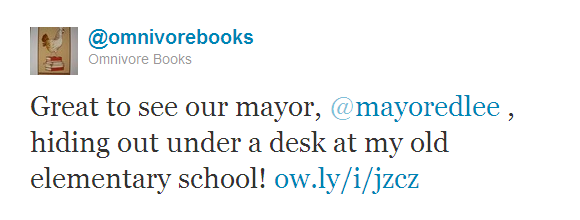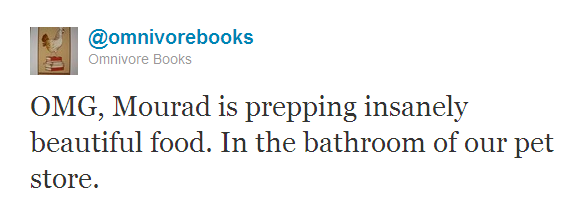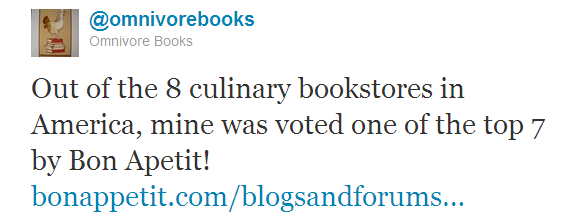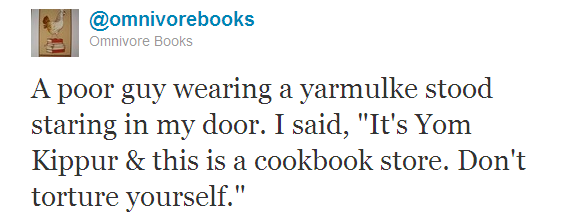Omnivore Books in San Francisco looks like a traditional bookstore. Opened three years ago in a former butcher shop, the small, bright room is stocked floor to ceiling with new and vintage cookbooks. Locals and tourists come by to browse, or they’re on a mission to buy the latest installment of Canal House or Lucky Peach. The proprietor, Celia Sack, is the person most often behind the counter.
Sack is also the person behind @OmnivoreBooks tweets like:
And:
Sack, who has been in retail for years (she and her partner opened Noe Valley Pet next door to Omnivore in 1999), believes that integrating her personality into the shop is a key part of its success. For the store’s Twitter account, she follows this rule: one third personal, two thirds professional. “You don’t want people to feel marketed to all the time,” she said. “It’s so important that I’m the face of the store — and that’s important digitally, too.”
So, while the majority of her tweets are, in fact, about store business — particularly the author events she holds almost nightly — her personality tends to come through in those posts, too:
And:
And:
The Omnivore Books account has more 7,000 unusually enthusiastic followers, and Sack says that people who come into the shop commonly introduce themselves by their Twitter handles. Often, they have stories that relate to something she posted, and though she’s careful not to divulge too much personal information, she readily shares enough of her sensibility that, as she puts it, “people feel warm and loyal.”
Interestingly, connecting with customers isn’t what Sack considers the biggest benefit of Twitter. When she opened the store in November 2008, she knew she wanted to hold a lot of author events. She figured she could build on her small circle of food-world connections to draw in speakers — chef Traci des Jardins (@chef_traci), for example, is a long-time friend. Plus, Sack could reach out to publishers who might be sending their authors on book tours. The first part of the strategy worked; the second part, not so much.
“Early on, I really wanted to have Flo Braker speak here, and I kept trying through the publisher,” Sack said. “They’d repeatedly say, ‘We’re trying to reach her,’ but nothing would happen. And then Flo contacted me and said, ‘I’d love to speak at your store.’ Of course, she hadn’t heard a word from the publisher.” Sack started to think that contacting authors directly would be a better way to go, but they weren’t always easy to find.
Then, in April 2009, a friend introduced Sack to Twitter. Sack took to it right away. She enjoyed the brevity, she liked posting observations from the store, and it fit with the intermittently busy-slow rhythm of retail. And here’s something special: Sack is not at all technical; she didn’t then and doesn’t now own a cell phone. (She tweets from the store’s desktop computer.)
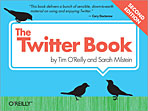 The Twitter Book — Omnivore Books (@OmnivoreBooks) is one of dozens of accounts whose tweets are used as examples in the fully updated “Twitter Book, Second Edition.”
The Twitter Book — Omnivore Books (@OmnivoreBooks) is one of dozens of accounts whose tweets are used as examples in the fully updated “Twitter Book, Second Edition.”Although Twitter was Sack’s “only technological milieu,” it didn’t take her long to figure out that she could use it to connect with other people. Food writer David Lebovitz (@davidlebovitz) was an early inspiration. “I wrote him [an @message] and said, ‘I know you don’t have a book now, but if you’re ever in SF, I’d love to have you come give a talk.” He responded enthusiastically, and the proverbial light bulb went off for Sack.
She began using Twitter to reach out to authors directly — whether they had books coming out or not (she included her email address so they could follow up easily). The outreach had two big benefits. First, authors would turn around and tell their publishers about Omnivore Books, which put the shop on the map. Cookbook publishers now routinely contact her (though Sack notes that it’s important for her to maintain a personal relationship with authors, in part because there’s a lot of turnover among publishing house publicists). Second, when she wrote to authors — Dorie Greenspan (@doriegreenspan), for example — people who followed them both would see the notes and chime in with comments about how great Omnivore is for readings. “Having that backup is powerful,” said Sack.
Sack wins over customers and authors alike with her idiosyncratic voice (I was surprised to learn that people ask all the time if she writes the store’s tweets; who could you pay to use the hashtag #BadLesbian in reference to yourself?). She emphasizes the importance of putting your personality into it and being interesting because that’s who you are, not because you want to draw followers for the sake of a higher number. And she adds, “The strategy is to make people feel included not excluded, to make them feel part of your world.”
She recalls a recent example: A guy planned to surprise his girlfriend with a marriage proposal in the store. Sack was nervous but excited and live-tweeted the episode, beat by beat. Her followers were riveted. “Tweeting about it was personal and spontaneous, and I happened to take out my camera — and it worked! I showed the couple all the responses. ‘Congrats from London.’ ‘Crying at our desks in Chicago.’ They were so overwhelmed. It was totally fun.” Later, she mentioned to me that she’d picked up 100 new followers that day.
Related:

